Types of Facilities

Although each type of commercial building faces unique challenges, facility managers can achieve significant water savings indoors and outdoors by adopting more water-efficient equipment and operational practices.
On This Page:
- Commercial and Institutional Sector
- Office Buildings
- Hospitals
- Hotels
- Restaurants
- Educational Facilities
- Industrial
Commercial and Institutional Sector
The commercial and institutional sector is the second largest consumer of publicly supplied water in the U.S., accounting for 17 percent of the withdrawals from public water supplies. This sector includes a variety of facility types such as hotels, restaurants, office buildings, schools, hospitals, laboratories, and government and military institutions. Each facility type has different water use patterns depending on its function. The chart below shows how water is used in different commercial and institutional facilities.
Figure 1-1. End Uses of Water in Various Types of Commercial and Institutional Facilities
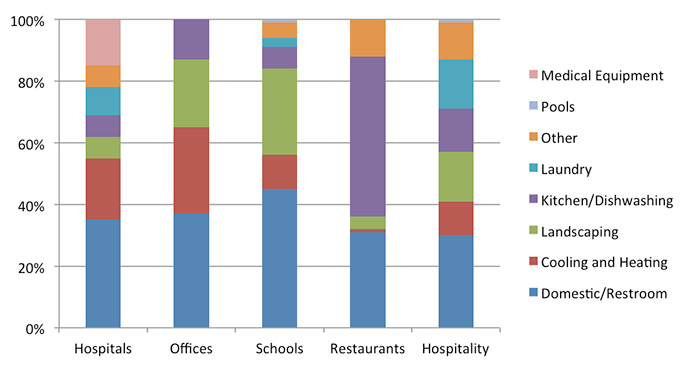
Office Buildings
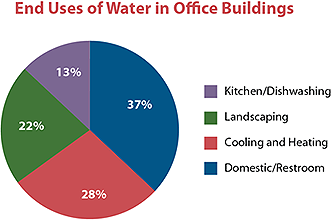 Approximately nine percent of the total water use in commercial and institutional facilities in the U.S. takes place in office buildings. The three largest uses of water in office buildings are restrooms, heating and cooling, and landscaping.
Approximately nine percent of the total water use in commercial and institutional facilities in the U.S. takes place in office buildings. The three largest uses of water in office buildings are restrooms, heating and cooling, and landscaping.
Download the Office Buildings Fact Sheet(2 pp, 662 K, About PDF).
Case Study
Learn how(2 pp, 774 K, About PDF) an office complex in Plano, TX reduced its water use by 40% by upgrading its irrigation systems and changing maintenance practices.
To save water in your office building, you can:
- Develop a water management plan.
- Assess your water use to identify opportunities for savings and track results.
- Check regularly for leaks and, when found, repair them promptly.
- Replace bathroom fixtures with more efficient models and check automatic sensors to ensure they are operating properly to avoid unnecessary water use.
- Use water smart landscaping and irrigation practices.
- Optimize your cooling systems and determine if they can provide or use alternative onsite sources of water.
- Review WaterSense at Work (308 pp, 6 MB, About PDF) for information on these practices and more.
Hospitals
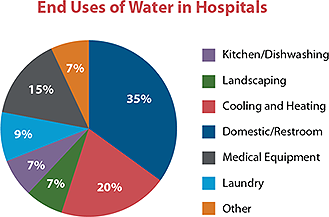 Approximately seven percent of the total water use in commercial and institutional facilities in the U.S. takes place in hospitals and other health care facilities. The largest uses of water in hospitals are cooling equipment, plumbing fixtures, landscaping, and medical process rinses.
Approximately seven percent of the total water use in commercial and institutional facilities in the U.S. takes place in hospitals and other health care facilities. The largest uses of water in hospitals are cooling equipment, plumbing fixtures, landscaping, and medical process rinses.
Download the Hospitals Fact Sheet(2 pp, 574 K, About PDF).
Case Study
Learn how(3 pp, 869 K, About PDF) a hospital in Olympia, WA is saving $140,000 a year in water and sewer costs due to its water efficient actions.
To save water in your hospital, you can:
- Develop a water management plan.
- Assess your water use to identify opportunities for savings and track results.
- Check regularly for leaks and, when found, repair them promptly.
- Replace bathroom fixtures with more efficient models.
- Retrofit or replace medical equipment to more efficient models.
- Eliminate single pass cooling by recirculating cooling water or moving to air-cooled systems.
- Evaluate equipment in cafeterias and laundry for potential water savings.
- Review WaterSense at Work (308 pp, 6 MB, About PDF) for information on these practices and more.
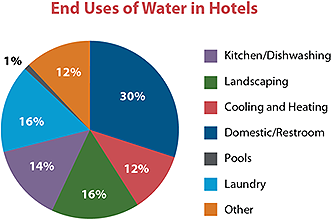 Hotels
Hotels
Approximately 15 percent of the total water use in commercial and institutional facilities in the U.S. takes place in hotels and other lodging businesses. The largest uses of water in hotels are restrooms, laundry operations, landscaping, and kitchens.
Download the Hotels Fact Sheet(2 pp, 708 K, About PDF).
 Learn More
Learn More
Join hotels across the U.S. save water by taking the WaterSense H2Otel Challenge! Pledge to become more water-efficient at your hotel and use our tools and technical support, such as webinars, case studies, and best management practices, to help you do so.
To save water in your hotel, you can:
- Develop a water management plan.
- Assess your water use to identify opportunities for savings and track results.
- Check regularly for leaks and, when found, repair them promptly.
- Upgrade your guests’ bathroom experience with more efficient fixtures.
- Consider water-smart landscaping and irrigation practices and control water losses from pools.
- Evaluate laundry equipment and food service areas for potential water savings.
- Review WaterSense at Work (308 pp, 6 MB, About PDF) for information on these practices and more.
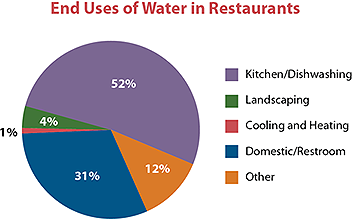 Restaurants
Restaurants
Approximately 15 percent of the total water use in commercial and institutional facilities in the U.S. takes place in hospitality and food service establishments. The largest uses of water in restaurants are associated with equipment and processes that take place in the kitchen. Restrooms follow kitchens as the second highest water use in restaurants.
Download the Restaurants Fact Sheet(2 pp, 480 K, About PDF).
To save water in your restaurant, you can:
- Develop a water management plan.
- Assess your water use to identify opportunities for savings and track results.
- Check regularly for leaks and, when found, repair them promptly.
- Upgrade dishwashers, ice machines, and steam cookers to ENERGY STAR qualified models.
- Replace equipment that discharges water continuously, such as food disposals and dipper wells, with more efficient models, or turn off when not in use.
- Clean up with more water-efficient spray valves.
- Check automatic sensors on bathroom fixtures to ensure they are operating properly and avoid unnecessary water use.
- Review WaterSense at Work (308 pp, 6 MB, About PDF) for information on these practices and more.
Case Study
Learn how(3 pp, 843 K, About PDF) three green restaurants in the country are saving water and energy by implementing a number of different best management practices.
Educational Facilities
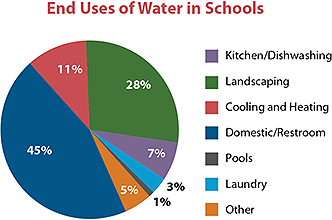 Approximately six percent of total water use in commercial and institutional facilities in the U.S. takes place in educational facilities, such as schools, universities, museums and libraries. The largest uses of water in educational facilities are restrooms, landscaping, heating and cooling, and cafeteria kitchens.
Approximately six percent of total water use in commercial and institutional facilities in the U.S. takes place in educational facilities, such as schools, universities, museums and libraries. The largest uses of water in educational facilities are restrooms, landscaping, heating and cooling, and cafeteria kitchens.
Download the Educational Facilities Fact Sheet(2 pp, 607 K, About PDF).
To save water at your educational institution, you can:
- Develop a water management plan.
- Assess your water use to identify opportunities for savings and track results.
- Check regularly for leaks and, when found, repair them promptly.
- Replace bathroom fixtures with more efficient models.
- Use water-smart landscaping and irrigation practices.
- Optimize your cooling systems and determine if they can provide or use alternative onsite sources of water.
- Evaluate equipment in cafeterias, laboratories, and other on-campus facilities for potential water savings.
- Review WaterSense at Work (308 pp, 6 MB, About PDF) for information on these practices and more.
Case Study
Learn how(3 pp, 1.51 MB, About PDF) the University of Texas at Austin decreased its campus potable water use by 33%.
Industrial
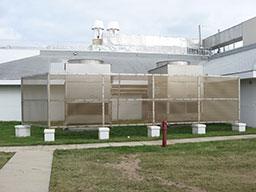 Industrial facilities can use many of the best management practices described in WaterSense at Work (308 pp, 6 MB, About PDF) to analyze the water used by technologies, systems, and processes in their facilities. For example, industrial facilities often use water to move products, change or maintain temperature, clean equipment, or prevent drying between the stations of a manufacturing assembly line.
Industrial facilities can use many of the best management practices described in WaterSense at Work (308 pp, 6 MB, About PDF) to analyze the water used by technologies, systems, and processes in their facilities. For example, industrial facilities often use water to move products, change or maintain temperature, clean equipment, or prevent drying between the stations of a manufacturing assembly line.
There are many ways industrial facilities can improve their water efficiency, including:
- Optimizing Processes: Industrial facilities may be able to improve water efficiency by evaluating the amount of water used in each step of a process or in between the steps of a process. EPA has created the Lean and Water Toolkit to help industrial facilities evaluate process water using pollution prevention and traditional manufacturing efficiency techniques. For more information about pollution prevention and process mapping, visit the Pollution Prevention Resource Exchange Exit to access guidebooks and case studies of successful assessments.
- Reusing Water: Depending on the water quality requirements, water from one step of a process can sometimes be recycled or reused in another part of the manufacturing facility. In some cases, pretreatment of this water may be necessary to control the concentration of contaminants before returning the water to the process or reused directly. For more information about water reuse, consult the EPA Guidelines for Water Reuse.
- Checking Permits: Facilities should contact their local water or wastewater utility for technical assistance before making any process changes that would affect the discharges or effluent of the facility. Wastewater discharges from all industrial facilities are regulated under the Clean Water Act through the National Pollutant Discharge Elimination System (NPDES). Each NPDES permit incorporates limits on specific pollutants set in effluent guidelines and/or pretreatment standards for a facility. Changes in the quality or quantity of water released could cause a facility to violate the terms of discharge permits issued under the Clean Water Act or other state, regional, or local codes or requirements.
- Accessing Incentives: Some water, wastewater, and energy utilities offer incentive programs for facilities to make process changes that improve water or energy efficiency. In addition, some state pollution prevention programs and universities provide subsidized auditing services for industrial facilities. Contact your local utility or technical assistance program to learn more about opportunities in your area.
